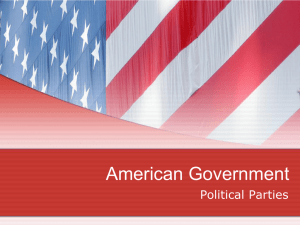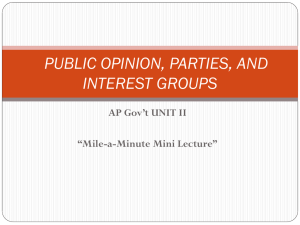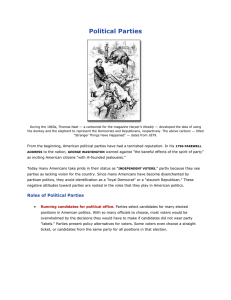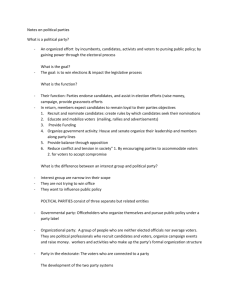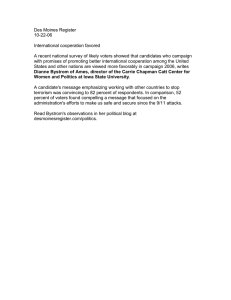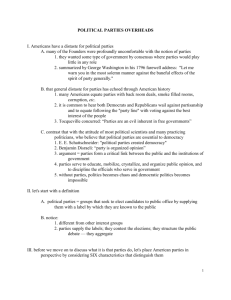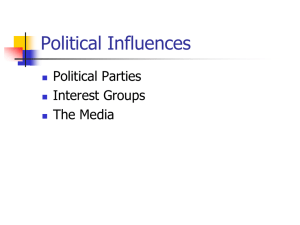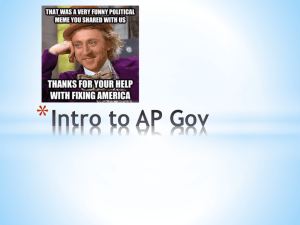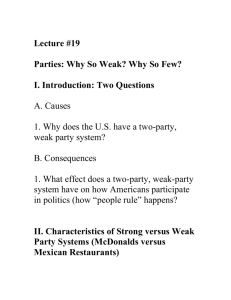Let's Get This Party Started: A History of Political Parties in the
advertisement
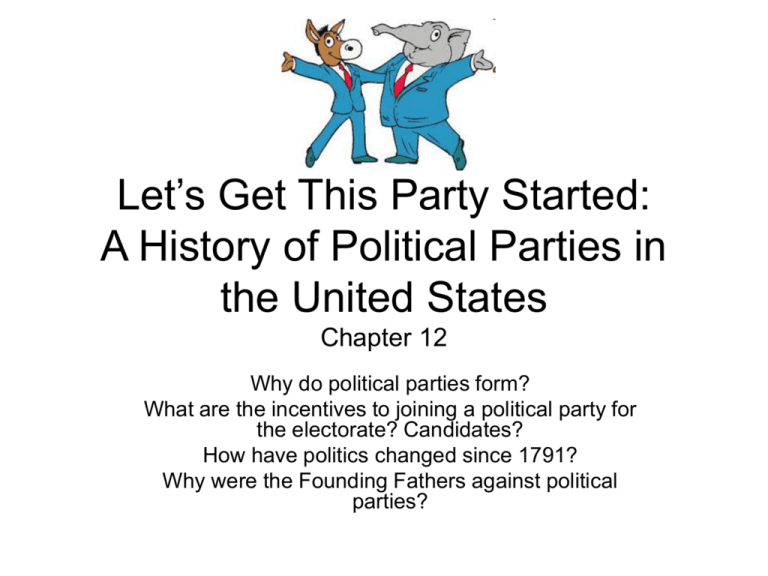
Let’s Get This Party Started: A History of Political Parties in the United States Chapter 12 Why do political parties form? What are the incentives to joining a political party for the electorate? Candidates? How have politics changed since 1791? Why were the Founding Fathers against political parties? What is a political party? • “organized effort by office holders, candidates, activists, and voters to persue their common interests…” Remember: • Politics: how policy decisions are made • Party: group of people • U.S. dominated by twoparty system, despite reforms and other parties • NOT an interest group, which exists to influence policy, not win office (this line is sometimes blurry) • #1 goal of political party: gain and exercise power through the electoral process • not just having a candidate, but winning office Who’s in a party? • Governmental party: office holders who organize and pursue policy objectives (agenda) under a party label – Those who are actually in the government • Organizational party: workers and activists who make up the formal organization of the party • Party in the electorate: voters who consider themselves associated with the party (those who usually vote along party lines) • Most parties tend to be moderate in view, since the aim of parties is to attract voters (most Americans have moderate views) The fight begins… Why did parties form? • Washington and others (Fed #10…) argued against the formation of “factions” early in the republic • The election of 1796 changed this view, when John Adams narrowly won President and Jefferson as VP – Constitution did not have a separate Prez/VP vote – Congressional factions formed around the competing ideas of these two men • Federalists—Adams/Hamilton • Dem-Republican (Anti-Feds)—Jefferson • Election of 1800 finally prompts creation and ratification of 12th Amendment – No widespread popularity of early parties (regional alliances) – Parties a means to settle dispute over strength of new federal system The “Era of Good Feelings” 1817-1825 • By 1816, the Federalists had lost most power; their last elected candidate was Adams (dissolved 1820) • During Monroe’s presidency, party politics nearly non-existent nationally – Parties continue at state level – States switch to popular election of Electoral College members, not state legislative votes Expansion 1820-1840 • Westward expansion increases electorate – Property req. for male suffrage abolished – Votes: 300,000 to 2 million! • 1832: First national nomination convention held by Democratic Party (replaces D-R) – “Jacksonian Democracy” polarizes voters 1828, 1832; creates national popularity for a party – Opposition forms Whig Party (“those who oppose tyranny”—favored congressional power over presidential) • 1832-1860: First broadly-supported two-party system in the Western World – Issue of slavery in the U.S. divides Whigs, new Republican Party formed 1854 by anti-slavery activists – Abraham Lincoln elected 1860 (“solid South” begins Dem Party voting tradition in place until 1920) “The Golden Age” 1874-1912 • Since 1860, two party system dominates • Party stability, dominance of org. l,s,n, impact on voters as central traits of era • Emigration fuels big-city political machines at l, s levels: party organization that uses incentives (jobs, favors…) to win voters – Degree of control over voters – NYC, Chicago… • Machines served political needs and supplemented social services for exploding population • Intense loyalty, devotion with very high voter turnout (75% or better between 1876-1900) • Eventually, corruption within organization and government taking on functions of parties (printing ballots, conducting elections…) leads to their end The Political Machine: Boss Tweed and Tammany Hall, NYC Modern politics • 1930s New Deal shifts social services as “rights” rather than privileges Power taken from parties • Progressives’ Direct primary system—selection of party candidates through ballots cast by voters – Removes power from party leaders; loosens tie between nominees and party organization • Civil services laws—acts that removed members of political parties and replace them with professionals who must pass c.s. exams Weakening of party system • Issue-oriented politics— focus on specific issues, rather than on party/candidate/other loyalties • IOP leads to ticket-splitting— to vote for candidates of different parties in the same election, based on issues that cut across party lines • Candidate-centered politics—focus on candidates, their particular issues and character, rather than on party affiliation Check it! • What was the 12th Amendment? Why was it passed? (Hint: use your Constitution) • Describe the history of political parties in America. • Why did political machines form? Do you think they could exist again? Why? • Why do we currently have the “ticket-splitting” phenomenon? • Is candidate-centered politics good or bad? Support your answer.
